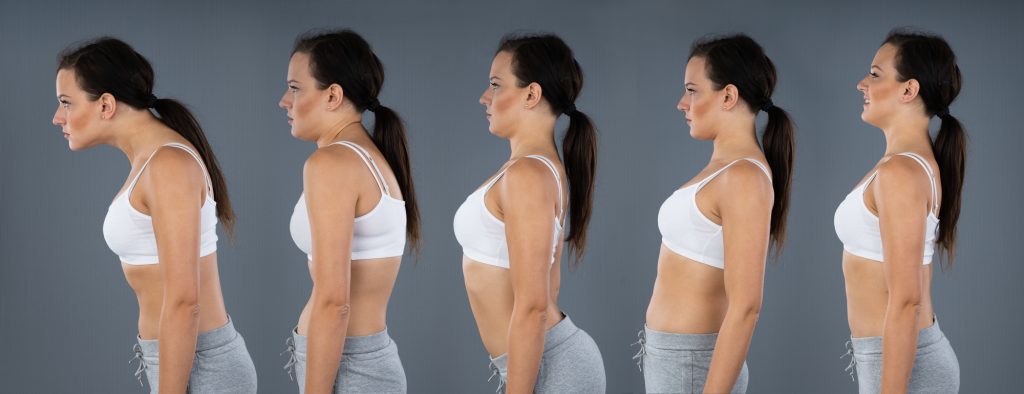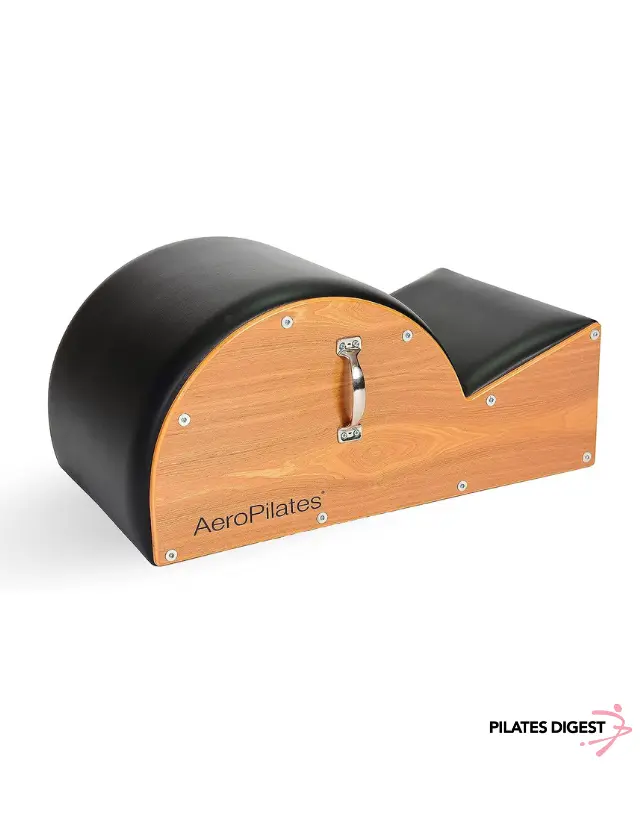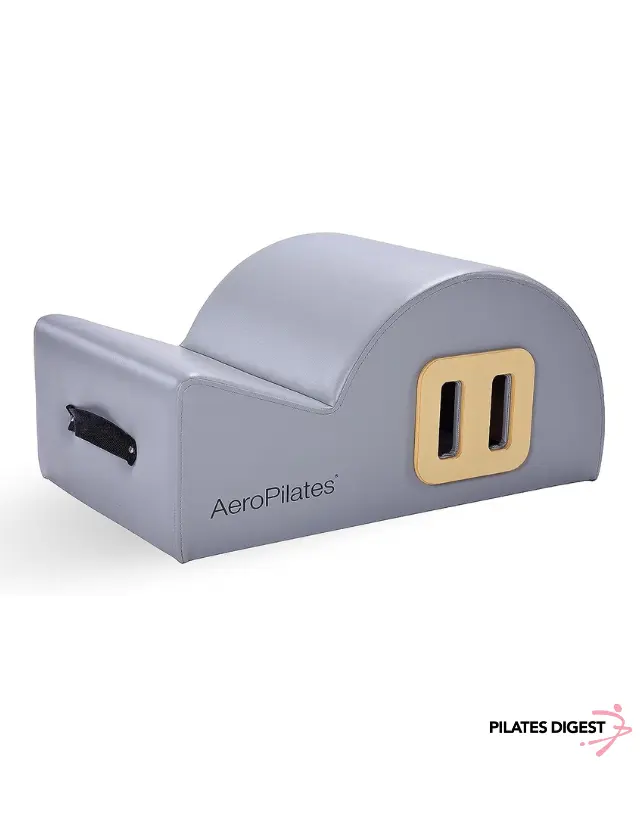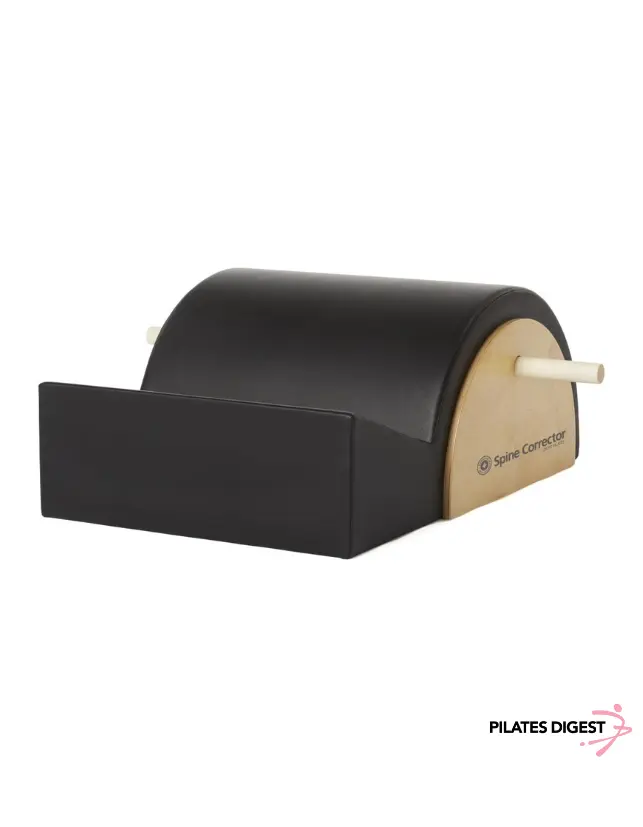Equipment

Correcting Forward Head Posture Through the Use of Pilates
Now more than ever, people are spending an extraordinary amount of time seated in front of various screens—from your computer at work to your phone, tablet and television at home, this sedentary lifestyle is putting a strain on our bodies in ways the human body wasn’t built to deal with. Whether you’ve heard of forward head posture before, chances are you are engaged in this damaging posture right now.
You may already be aware that your head posture is the culprit behind your sore neck and tight shoulders, but forward head posture can also result in increased tension headaches, mid and low back pain, as well as difficulty with breathing properly.
Experts have deemed that proper alignment of the body sees the hips, shoulders and ears in alignment. This is known as the “plumb line” or gravity line. Many people don’t realize, but for every 2.5cm past “plumb” that the head sits forward, the weight of the head increases by about 10lbs. The angle at which the head is tilted forward adds additional stress on the spine. Just 15 degrees of tilt adds 27lbs of pressure, and when texting, most people have their head at a 60 degree tilt, adding a whopping 60lbs of pressure to the spinal cord. Knowing this, it’s easy to see why so many people suffer from various forms of back and neck pain and why it is so important that an attempt is made to correct this issue.
A large part of Pilates practice focuses on proper alignment of the body, which makes it a great tool for working toward correcting forward head posture. As well as increasing mindfulness toward the body, Pilates also seeks to create balance by creating strong yet flexible muscles. As forward head posture pulls the spine out of alignment, it creates an imbalance of weak, elongated upper back muscles and tight chest muscles that Pilates is well suited to deal with.
Strengthen the Back to Support the Head
A strong back will help to support the weight of your head, protecting both your neck and spine. For example, try pulling your shoulder blades together and down your back, notice how your shoulders immediately lifted and pulled back, reversing the forward slump that comes hand-in-hand with forward head posture.
The muscles that performed this action are the rhomboids. Strengthening these and other muscles in the back will help to support your head and help you to sit up straighter for longer periods of time without fatiguing.
A good exercise that will help to both stretch and strengthen is back extensions using a Pilates barrel. You can use either a small or step barrel. The barrel will help to support your body, and through that support aide with better alignment during various exercises. Bending backward over the barrel can be done passively, which simply uses the body’s own weight to stretch the muscles of the back as well as open the pectorals. It can also be done actively by using the spinal extensor muscles, which include the erector spinae, to lift the torso off the barrel. In this instance, the barrel acts more as a guide than a full support.
One of the trickle down effects of forward head posture is pain in the lower back. A small barrel can be helpful in releasing some of those tight, painful muscles in the low back. With the small barrel placed on a mat, rest your lower back on the top of the barrel. Your hips should be placed on the top of the barrel, while the natural curve of your lower back should be supported with your upper back rounding over the side of the barrel. You may wish to place a towel under your head for support or personal comfort. Traditionally the legs would be held out at about a 45-degree angle, but you may find that places too much stress on the lower back. Consider placing the feet on a raised surface to relieve some of the pressure in your back.
Strengthen the Core to Support Improved Posture
A strong core is crucial to good posture in that your core muscles help to hold you up and avoid slouching. Slouching, rounded shoulders and forward head posture are all related, so strengthening the core is important to maintaining proper form while seated or standing.
An arc barrel or step barrel are great for strengthening the deep core muscles. Seated on the floor with the rounded side of the barrel (if you’re using a step barrel) pressed into the low back, engage the core muscles by pulling the abdominals inward (picture trying to connect the abdominals to the barrel through the back). Using your abdominal muscles, slowly lower your back down onto the barrel with arms stretched out in front of you. Go as slowly as you can and think about lowering the back one vertebrae at a time. Knees can be bent or fully extended, whichever is more comfortable. You may only be able to drop down to just below the shoulder blades when starting out and that’s okay. To finish the movement, use the abdominals to lift your torso back up to a seated position. Use a yoga mat with a bit of grip under the barrel if you find it sliding away from you.
1. AeroPilates Spine Corrector Barrel

Materials and Origin: The AeroPilates Spine Corrector Barrel is made of hardwood, foam, and vinyl, ensuring durability and comfort. It’s imported, which might be a consideration for those who prioritize locally-made products.
Functionality:
-
Posture Correction: The primary function of this product is to correct posture. It aids in restoring the spine’s natural curve, which is essential for overall back health and posture. This can be particularly beneficial for those who spend long hours sitting or have developed poor postural habits.
-
Full Body Workout: Beyond posture correction, this barrel offers a full-body strength workout. It targets the abs, back, shoulders, thighs, and core stabilizers. This multifunctionality makes it a versatile addition to any home gym.
-
Breathing: The design of the barrel promotes deeper, easier breathing by opening the spine. This can be a game-changer for those who practice meditation, yoga, or any activity that requires controlled breathing.
Design and Portability:
-
Comfort: The padded, upholstered vinyl surface ensures that users can comfortably use the barrel in various poses. This is crucial as discomfort can deter consistent use.
-
Portability: The built-in carrying handle is a thoughtful addition, making it easy to move the barrel around or take it to different locations.
Additional Features:
- Instructional DVD and Videos: For beginners or those unfamiliar with pilates, the included DVD and on-demand videos are invaluable. Having guidance from Master Pilates Instructor Romana Kryzanowska and AeroPilates elite trainer Marjolein Brugman ensures users can get the most out of the product safely.
Advantages:
- Restores spine’s natural curve for improved posture.
- Full-body strength workout targeting core and back.
- Promotes deeper, easier breathing by opening the spine.
- Comfortable padded design for extended use.
- Portable with built-in carrying handle.
- Includes instructional DVD for guided workouts.
You can see this posture corrector here
2. AeroPilates Precision Series Spine Corrector

The AeroPilates Precision Series Spine Corrector is a piece of Pilates equipment designed to help users improve their posture, strengthen their core and back muscles, and promote deeper breathing. Here’s a concise summary of the product description:
AeroPilates Precision Series Spine Corrector Features:
- Posture Improvement: Helps restore the spine’s natural curve and promotes proper posture.
- Full-Body Workout: Strengthens abs, back, shoulders, thighs, and core stabilizers for comprehensive toning.
- Enhanced Breathing: Opens the spine for deeper, easier breathing by reducing pressure and elongating the spine.
- Comfort & Portability: Features a padded, upholstered vinyl surface for comfort. Lightweight with a built-in handle for easy transport.
- Online Workouts: Comes with two online workout videos led by AeroPilates expert Shauna Smith-Yates, covering a Level 1 Workout and a Back Care Routine.
Advantages:
- Restores Spine Curve: Promotes proper posture.
- Full-Body Toning: Strengthens abs, back, and thighs.
- Enhances Breathing: Opens and elongates the spine.
- Comfortable Design: Padded, upholstered vinyl surface.
- Portable: Lightweight with carrying handle.
- Guided Workouts: Includes expert online videos.
You can see this posture corrector here
3. STOTT PILATES Merrithew Spine Corrector

The STOTT PILATES Merrithew Spine Corrector appears to be a well-constructed and purposeful piece of equipment designed to address spinal alignment issues. Its sturdy construction and comfortable padding make it suitable for both professional and home use.
Who might benefit from this product?
- Individuals with postural issues or those who have lost the natural curvature of their spine due to prolonged sitting or other lifestyle factors.
- Pilates enthusiasts or practitioners who want to add a new dimension to their workouts.
- Rehabilitation centers or physical therapy clinics that work with patients recovering from back injuries or surgeries.
- Fitness studios or home gym owners looking for specialized equipment to enhance their exercise regimen.
Advantages:
- Corrects and restores spine’s natural curve.
- Durable Baltic Birch and Maple construction.
- Dense EVA foam for comfort.
- Easy assembly with supplied screws.
- Suitable for professional and home use.
- Enhances Pilates and rehabilitation exercises.
You can see this posture corrector here
To engage the obliques during the exercise, add a slight rotation to either the right or the left as you rise back up to sitting. Be careful not to twist too far or too fast. If you are twisting to the right, your left shoulder should come no further over to center than the outside edge of your left leg.
These exercises can be done seated on the step of a step barrel, but keep in mind that doing so will increase the difficulty, so it may be best to start on the rounded side to begin with.
Another really simple but effective abdominal exercise is the roll down. It can be done anywhere including a quiet corner at work when you’re taking that all important stretch break. Standing with your back against a wall and feet together, tilt your head forward and allow your upper body to roll downward as your hands reach toward your feet. Imagine that you are bending forward, vertebrae by vertebrae, nice and slow. Keep the abs engaged and slowly return back up to standing. Once you’ve done this about 10 times, pause in the downward position for about 30 seconds before returning to the upright position. This gives your back a nice, well-deserved stretch as well.
Release Tight Muscles to Increase Mobility
A step barrel can be extremely useful in opening up tight muscles in the upper body and correcting the rounded shoulders. Side lateral bending is a great way to open up tight muscles. This can be done on a small barrel, but the step barrel will give you the added benefit of helping to properly align the hips during the stretch. While seated sideways on the step of the barrel, keep the knees bent as if still in a seated position. The arm that is closest to the floor can act as a support while you exhale and stretch up and over your head with your top arm. At the same time you are drawing an arc with your upper arm, you’ll be extending your top leg out straight. Allow the barrel to support you while your entire upper side gets a wonderful stretch. Inhale in the extended position to open up the ribs and receive an even deeper stretch, and then exhale as you bring your arm back down in the same arc as you pull your leg back in. Repeat the motion 5–8 times. This can help to improve shoulder mechanics while releasing tight muscles down the side and through the hips.
On the mat, the superman exercise is extremely beneficial in counteracting the effects of rounded shoulders, which are a bi-product of forward head posture. This exercise will also help to open up those tight pectoral muscles. Lying face down on a mat with arms extended down beside the body and fingers pointing toward the toes, engage your core and lower back. Exhale as you lift your chest off the mat, making sure to keep you head in line with your spine. Squeeze your shoulder blades together and down your back as your reach toward your toes with your fingers. Slowly lower back onto your stomach before repeating the maneuver.
As well as stretching, you can perform self-myofascial release to help reduce tension in the upper shoulders and neck. One way to do this is to lay flat on your back with knees bent and feet flat on the floor. Place a tennis ball (or any ball roughly that size) to either side of the spine. You can rest your head on a low cushion or block to make the pressure of the ball more manageable. Slowly move around until you find a sore spot and then stay in place on the spot for about 10-20 seconds. Once you get used to doing this, you may even be able to detect a release in the muscle. Keep moving around, looking for sore spots. Your upper back and even your shoulders should feel a little looser after doing this.
Increase Your Mindfulness of Your Body
While the exercises mentioned above can go a long way to resetting your posture, if you aren’t being mindful about keeping your head in that aligned position outside of the time spent exercising and stretching, you’ll essentially be losing a game of tug-of-war with yourself. The fact that we spend so much time in these unhealthy postures means they become learned behaviors and we have to work even harder to break these habits. Creating new habits can only be done by constantly checking in with our bodies.
Try setting an alarm to go off at least every hour while you are working. Get up and move around, even if it’s only for a quick stretch. While you’re up, try standing with your back against a wall. If the back of your head isn’t touching the wall, you have your head too far forward. When you first touch the back of your head to the wall, it may seem like a position that is very foreign to you—that is simply because of how much time we spend in a forward head position. If you can practice this stance every chance you get, it will slowly start to feel more comfortable and you’ll be able to integrate it into other parts of your day. When you sit back down, check in with the position of your head. Even a Post-it note stuck to the top corner of your screen can help to keep good posture at the forefront of your mind.
Another exercise that you can do almost anywhere is to place your fist under your chin and press upward as if trying to tilt the head back. Feel your neck muscles engage as you push back against your hand. Try not to clench your jaw, though; this exercise should be primarily about the neck and can be a good way to strengthen your neck muscles, which will help to protect your spine and support your head. Perform this exercise several times during the day.
When using a tablet or phone, whether at work or at home, try bringing the screen up to the level of your eyes instead of tilting your head forward and down. Everyone knows you’re on your phone, so you may as well be as comfortable as possible.
Additional Measures to Correct Forward Head Posture
Outside of exercising, improving mobility and increasing your awareness of your body, you can take additional steps to help improve the alignment of your body. Another bi-product of our overworked yet sedentary society is that people are spending only around seven hours sleeping each day. That may not seem like much, but even so, try to make sure that your body is properly supported during those hours. Get a more supportive pillow to reduce neck strain. An orthopedic pillow works really well in that it holds the neck in a more neutral position rather than letting the head fall forward. This of course is a matter of personal comfort. Tossing and turning because you don’t like your pillow won’t do you any good at all.
You should also take a look at your work station and make adjustments so that the space where you spend most of your time will be more ergonomic. Change the height of your screen so that you are looking at the top third of your screen when looking straight ahead. Invest in a more supportive chair if you work at home. If possible, one with a headrest will act as a good cue to proper posture. If your head is coming off the headrest, you are leaning too far forward.
Reach out for help at work to see what assistance may be available. Even a back support device for your time in the office can make a big difference, and many companies are becoming more aware of the importance of ergonomic work stations. While we can’t change the number of hours that we spend in front of a screen at work, we can make sure we are using the best posture possible.
While it’s clear that our sedentary lifestyle is not going to change any time soon, there are steps to be taken to combat this rising issue. As with many things in life, though, it should be mentioned that forward head position and all the issues that come along with it cannot be fixed overnight; time and patience are required to see lasting results.
If you are suffering from severe or prolonged pain, or have been recently diagnosed with arthritis in your neck, it’s important to see a doctor as there may be a more serious issue at play. Pilates can be extremely helpful as a recovery tool and for those suffering from the effects of arthritis, but a professional should always be consulted before beginning a new program or trying exercises you are unfamiliar with.





